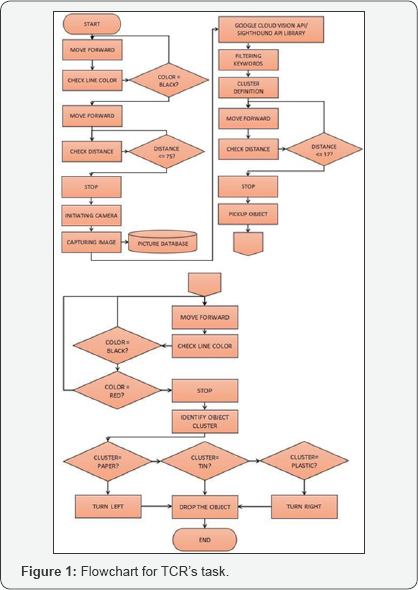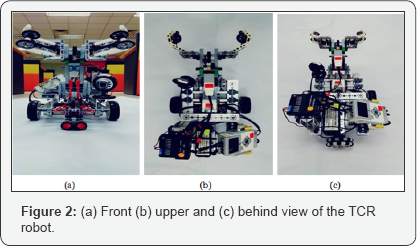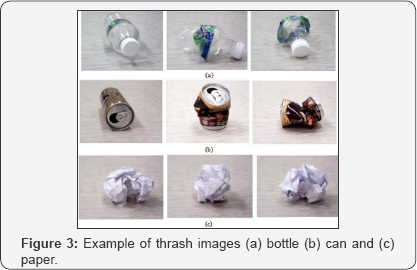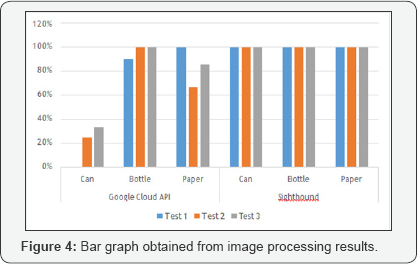Image Processing Technique using Google Cloud API and Sighthound for Lego Mindstorms EV3 Robot- Juniper Publishers
Juniper Publishers- Journal of Robotics
Abstract
The world today faces major garbage crisis that are
due to the product of rapid economic growth, overcrowding, poor urban
planning, corrosive corruption and political dysfunction. Presently,
many have tried and tested methods of garbage collection but the current
methods are proven to be ineffective. In this era of higher technology,
humanoid robots are found to be the trends in most of the applications.
Humanoid robots can support people in everyday life. The industry is
moving towards the current side of automation to increase productivity
and to deliver uniform quality. Thus, Trash Collecting Robot (TCR) is
proposed to help in providing automatic control to collect the garbage.
TCR is built by using Lego Mindstorm EV3 robot and it can differentiates
between the static and dynamic obstacles and moves accordingly as it
programmed. Basically, TCR consists of sensors at different levels to
detect the dynamic obstacles and it implements image processing
techniques where it can identify the type of waste material that has
been collected. In image processing part, cloud services via Google
Cloud API and Sighthound are used to identify the trash type whether
plastic, can or paper. The result shows that Sighthound outperforms the
Google Cloud by getting almost 100% accurate on classifying the trash
type.
Keywords: Image processing; Lego mindstorm EV3 robot; Google Cloud API; Sighthound Introduction
The robots are human like machines capable of doing
duty they are programmed to do. They have shown significance in
decreasing human work, especially in industries. In manufacturing tasks,
speed and efficiency have long been improved by robotic systems. A
robot has replaced humans in many industries especially in repeated or
dangerous situations. A line follower robot is mostly a robot model for
tracking and follows a pre-defined black line or path on a white surface
[1].
The importance in the robotics field has been realized by researcher
since the beginning of the development of machine vision because it
provides a useful tool for the environment detection and decision making
during the automation process. The drawbacks of robotic operations are
extra hours needed for programming the operations and they are limited
to certain predefines operation that will cause rigid automation. One of
the solution to improve the adaptability of the system is by
integrating image processing system to robotic system and make it open
to other potential application for example work done by [2] aims to imitate the human behavior in sketching human facial portraits.
There are 10 types of new robotic trends which are
bioinspired robots, micro-nano-femtorobots, walking machines, toy
robots, ubiquitous robots, household robots, cloud robots, flying
robots, autonomous driving vehicles and modular self-reconfiguring
robots. Cloud robots are said to be exciting possibilities in the near
future because of its reduced requirements for on-board processing and
this can increase efficiency in performing complex tasks [3].
A Google researcher claims that cloud computing could make robots
smaller, cheaper, and smarter by calling this approach as cloud robotics
and it allows the robot to off load compute-intensive task like image
processing. Thus cloud robotics could make that possible by expanding a
robot’s knowledge beyond its physical body [4].
This paper proposed thrash collecting robot which can
classify the thrash type and insert it into the corresponding bins.
Here, a comparison between two cloud services for image processing which
are Google Cloud API [5] and Sighthound [6] will be executed.
Thrash Collecting Robot (TCR)
The proposed robot will do image processing to
recognize the type of recyclable trash and allocate them into a
different type of recycling bin. For the image processing part, cloud
services are used to understand the content of the captured image. Figure 1 shows the flow of TCR 's task, Figure 2 presents the TCR robot from different views and Figure 3 shows example of thrash images have been used.



Experiment and Results
TCR can move on a smooth track. LEGO Mindstorms EV3
is used as the brain for processing all the commands and TETRIX set is
used as the brawn to support the architecture. TCR also can pick-up the
objects once they sense their presence and take a picture of them using
the wireless camera to distinguish its type and class via Google Cloud
Vision API and Sighthound. After TCR is able to identify what type of
the objects that it has collected, it will separate them into a
different place with a different colour. Table 1 & 2
present the accuracy of identifying the type waste material based on
the captured image using Google API Cloud Vision and Sighthound
respectively (Figure 4).



Conclusion
In summary, robotics and automation significantly
advance the life sciences. TCR that is based on Lego Mindstorm EV3 robot
have been built to help in providing automatic control to collect the
garbage. Image processing system have been integrated into TCR and a
comparison between Google Cloud Vision API and Sighthound have been
made. From the experiments, it is found that Sighthound can identify
type of waste material efficiently compared to Google Cloud Vision API.
In the future, we proposed that large scale processing works such as
image processing need to be done in an environment with better
processing power. To achieve that, the robot should be equipped with a
wireless camera and a network card. Wireless camera will capture an
image of an object and the metadata of the image will be sent to the
server for image processing task. All the heavy processing work will be
done at the server and eventually results will be returned, and the
robot will be able to identify the type of trash.
For more open access journals please visit: Juniper publishers
For more articles please click on: Robotics & Automation Engineering Journal


Comments
Post a Comment